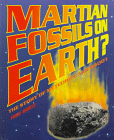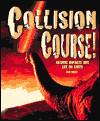 Managing Martians by Mars Pathfinder/Sojourner manager Donna Shirley with Danelle Morton (review) (1998);
Managing Martians by Mars Pathfinder/Sojourner manager Donna Shirley with Danelle Morton (review) (1998);and two 1999 biographies of Carl Sagan by
 Keay Davidson (review)
Keay Davidson (review)and
 William Poundstone (review).
William Poundstone (review).For young readers
Whenever the opportunity arises, this section will double as the bald-faced self-promotion department. Readers in the 9-14 age range can discover the latest discoveries about life on Mars and the role of cosmic impacts on life on Earth in my books
 Martian Fossils on Earth? (1997) and
Martian Fossils on Earth? (1997) and Collision Course! (2001), both published by Millbrook Press and described on my children's science website.
Collision Course! (2001), both published by Millbrook Press and described on my children's science website.Also on the Web
If you like the books mentioned here, you can spend many educational and enjoyable hours at NASA's Planet Quest web site, discovering one new world after another. The Christian Science Monitor web site has an on-line preview of that site.
About the reviewer
Columnist and reviewer Fred Bortz is a Ph.D. physicist and author of science books for young readers. He teaches science and writing at Chatham College in Pittsburgh, PA.


 Shop for this title at discount price
Shop for this title at discount price Planetary Dreams: The Quest to Discover Life Beyond Earth (Wiley, 320 pages, $16.95), DNA researcher Robert Shapiro skillfully blends history with the latest discoveries, arguing that the best way to resolve modern controversies is to pursue ancient dreams with futuristic technologies.
Planetary Dreams: The Quest to Discover Life Beyond Earth (Wiley, 320 pages, $16.95), DNA researcher Robert Shapiro skillfully blends history with the latest discoveries, arguing that the best way to resolve modern controversies is to pursue ancient dreams with futuristic technologies. The Worlds of Galileo: The Inside Story of NASA's Mission to Jupiter [by way of Venus and Earth] by Michael Hanlon with Foreword by Arthur C. Clarke (St. Martins, 2001, 240 pages, $29.99) and
a similar title not mentioned in the print column,
The Worlds of Galileo: The Inside Story of NASA's Mission to Jupiter [by way of Venus and Earth] by Michael Hanlon with Foreword by Arthur C. Clarke (St. Martins, 2001, 240 pages, $29.99) and
a similar title not mentioned in the print column, Mission Jupiter: The Spectacular Journey of the Galileo Spacecraft by Daniel Fischer (Copernicus, 2001, 336 pages, $32.00);
Mission Jupiter: The Spectacular Journey of the Galileo Spacecraft by Daniel Fischer (Copernicus, 2001, 336 pages, $32.00); Imagining Space: Achievements * Predictions * Possibilities 1950-2050 by Roger D. Launius and Howard McCurdy with foreword by Ray Bradbury (Chronicle, 2001, 176 pages, $35.00);
Imagining Space: Achievements * Predictions * Possibilities 1950-2050 by Roger D. Launius and Howard McCurdy with foreword by Ray Bradbury (Chronicle, 2001, 176 pages, $35.00); The Infinite Journey: Eyewitness Accounts of NASA and the Age of Space by William E. Burrows with foreword by Walter Cronkite (Discovery Books, 2000, 240 pages, $40.00).
The Infinite Journey: Eyewitness Accounts of NASA and the Age of Space by William E. Burrows with foreword by Walter Cronkite (Discovery Books, 2000, 240 pages, $40.00). Beyond UFOs: The Search for Extraterrestrial Life and Its Astonishing Implications for Our Future by Jeffrey Bennett
Beyond UFOs: The Search for Extraterrestrial Life and Its Astonishing Implications for Our Future by Jeffrey Bennett Civilized Life in the Universe: Scientists on Extraterrestrial Intelligence by George Basalla
Civilized Life in the Universe: Scientists on Extraterrestrial Intelligence by George Basalla Life as We Do Not Know It by Peter Ward
Life as We Do Not Know It by Peter Ward The Planets by Dava Sobel
The Planets by Dava Sobel The Life and Death of Planet Earth: How the New Science of Astrobiology Charts the Ultimate Fate of Our World by Peter D. Ward nd Donald Brownlee
The Life and Death of Planet Earth: How the New Science of Astrobiology Charts the Ultimate Fate of Our World by Peter D. Ward nd Donald Brownlee What Does a Martian Look Like? The Science of Extraterrestrial Life by Jack Cohen and Ian Stewart
What Does a Martian Look Like? The Science of Extraterrestrial Life by Jack Cohen and Ian Stewart The Neptune File by Tom Standage(review) (2000).
The Neptune File by Tom Standage(review) (2000). Planet Quest by Ken Croswell (review) (1997);
Planet Quest by Ken Croswell (review) (1997); Other Worlds: The Search for Life in the Universe by Michael D. Lemonick (review) (1998); and
Other Worlds: The Search for Life in the Universe by Michael D. Lemonick (review) (1998); and The Search for Life on Other Planets by Bruce Jakosky (review) (1998).
The Search for Life on Other Planets by Bruce Jakosky (review) (1998). Sharing the Universe: Perspectives on Extraterrestrial Life (1998) and
Sharing the Universe: Perspectives on Extraterrestrial Life (1998) and Rare Earth: Why Complex Life is Uncommon in the Universe by Peter D. Ward and Donald Brownlee (2000).
Rare Earth: Why Complex Life is Uncommon in the Universe by Peter D. Ward and Donald Brownlee (2000). Shoemaker by Levy: The Man Who Made an Impact by David Levy (2000);
Shoemaker by Levy: The Man Who Made an Impact by David Levy (2000);